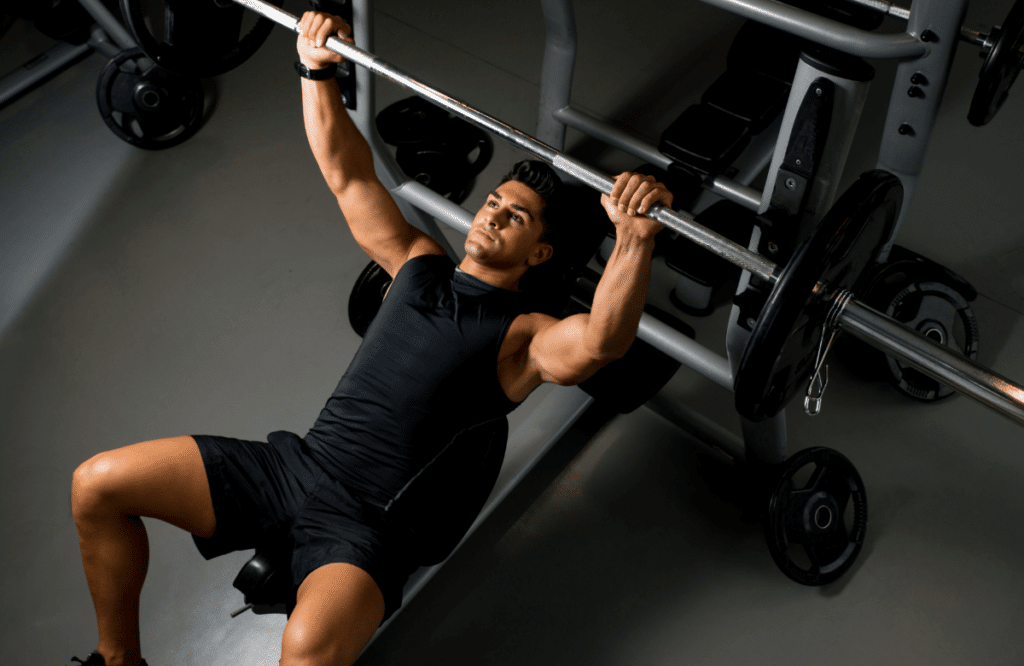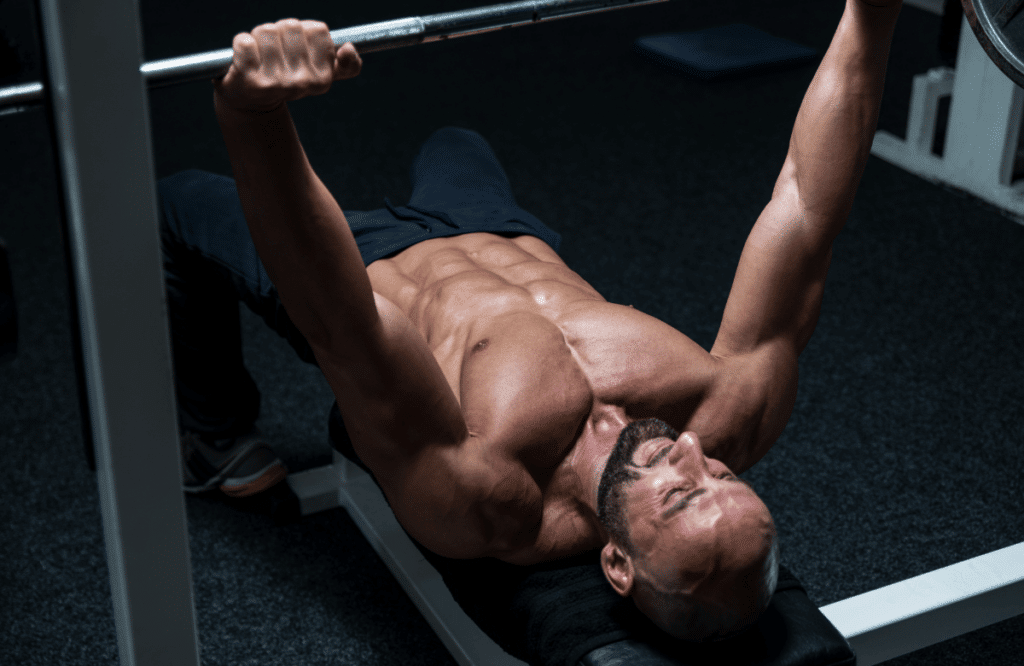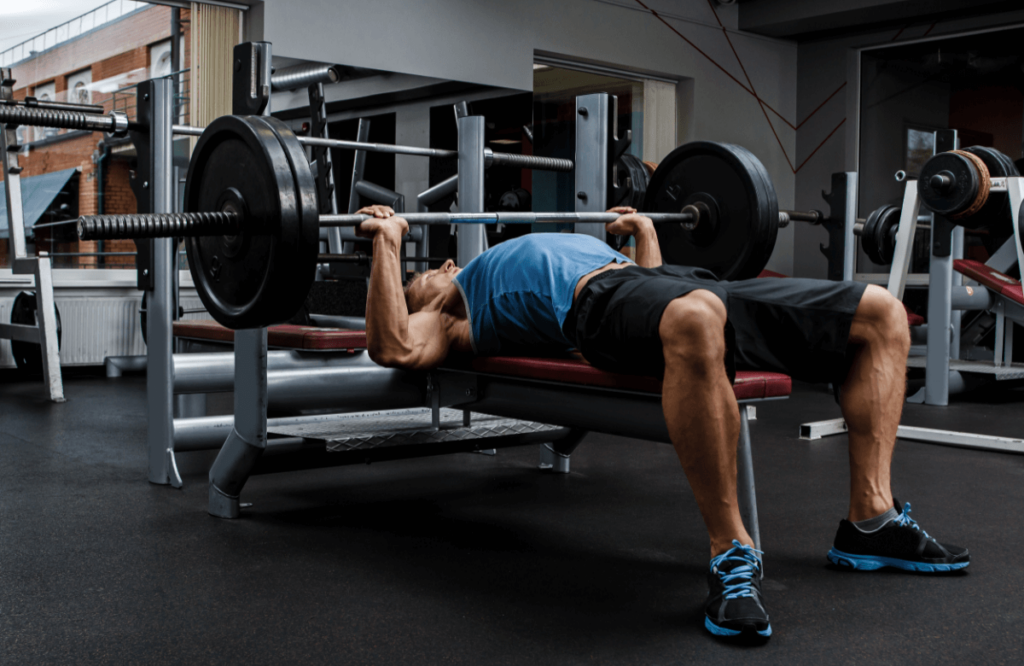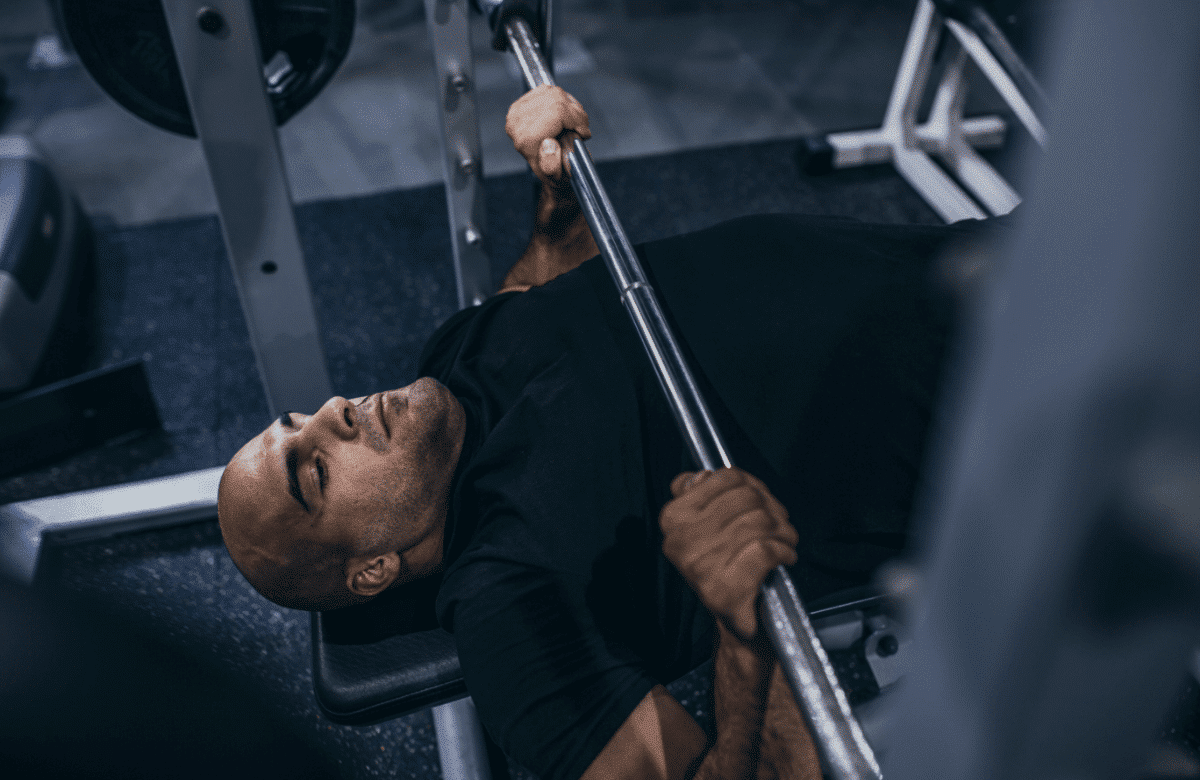While the traditional bench press strength training exercise has been a staple in workout routines for decades, there are still various techniques and grips that can be used to optimize results and achieve proper form. One such technique is the suicide grip, also known as the false grip or thumbless grip.
But how exactly can you benefit from the suicide grip during bench press? Is it actually as dangerous as its name suggests? Can you still safely incorporate it into your training routine? As it turns out, there’s much more to it than just simply grasping the bar in a slightly different way.
Jump to:
What Is the Suicide Grip and How to Do It?
The suicide grip is a technique in which you place your thumb on the same side of the bar as your fingers, rather than wrapping it around the bar. This creates a “false” grip, with no contact between your thumb and the bar. This has a direct effect on your range of motion and grip strength during the exercise since you rely solely on your fingers and wrists to hold the weight.
To achieve this grip, it’s advisable to have a spotter or training partner assist you in placing your hands on the bar. Start by laying down on a flat bench as you would for a traditional bench press. Then, have your spotter hand you the bar and guide your hands into position. It’s important to note that using the suicide grip requires proper technique and guidance, so it should not be attempted without assistance from someone experienced in this bench press exercise.
Once you’re in a neutral position on the bench, you need to keep your thumbs tucked underneath the bar instead of wrapping them around it. Make sure to squeeze the bar tightly as you would with a traditional grip, and maintain this grip throughout the entire lift. Slowly start moving the bar down towards your chest, keeping your elbows slightly tucked in.
Even though conventional bench pressing is one of the best upper-body workouts to build strength and endurance, straying from the regular grip can help you switch up your training and target different muscles in your upper body. While you don’t necessarily have to use the suicide grip, it’s worth exploring to see if it benefits your workout routine.
Advantages of Using the Suicide Grip
If you really want to give the false grip bench press a try, you need to be aware of the advantages it can offer you. Of course, these occur primarily when performing exercises that require a significant amount of strength and stability in the upper body.

More Natural Wrist Position
A neutral wrist position refers to the natural position of your hand when fully extended. By using the suicide grip, you can achieve this wrist alignment, which is much more comfortable and efficient for your wrists during the press.
Essentially, the proximal carpal bones in your wrists are better supported and stay in vertical alignment, reducing the strain on your joints. When this happens, the radius and ulna of the forearm are also more aligned, in a generally straight line coming from the elbow to the wrist.
In this way, you’re minimizing the leeway the wrist needs to move forward and back, which is very different from the pronated position that traditional bench pressing requires. Ultimately, this allows you to focus on building tension in your muscles rather than worrying about wrist pain or discomfort.
If you keep the barbell for the bench press positioned at the base of your palm, your wrists won’t extend too far back. This also permits you to keep your grip closer to the edge of the bar and maintain a more unified lineup through the wrist, arm, and shoulder.
It’s worth noting that using a wide grip in this kind of exercise can potentially negate these positives, especially since it creates more stress on the wrist joint. When you’re doing a close-grip bench press, however, this kind of grip can prove extremely beneficial. In this way, you have more control over your wrist and elbow alignment, which is ultimately better for your shoulder positioning.
More Comfortable for Your Shoulders
While doing powerful exercises for bigger shoulders, you’re essentially using your deltoid muscles to power the workout. These joints take the brunt of the load, with a lot of strain on the rotator cuff muscles that play a crucial part in bench press workouts. The wrong grip can lead to an injury or poor alignment, but the suicide grip can help alleviate some of these risks.
When you use the traditional tight-grip form where your fingers are wrapped around the bar, you’re forcing your shoulder into an internally rotated position. This can be quite uncomfortable, regardless of how careful your technique is. Even if you take all of the necessary precautions, this position can still cause discomfort in this area due to the increased pressure on your shoulders.
The suicide grip, however, allows for more natural shoulder positions. You’re able to comfortably rotate your shoulder externally and have it in a healthy position, reducing stress while performing bench press exercises. This is especially beneficial if you have existing shoulder issues or are looking to prevent them.
Plus, it can also minimize the elbow flare that occurs with traditional grip bench pressing and can lead to discomfort in the elbow joint. This involves keeping your elbows tucked near your sides as you perform the bench press, putting less pressure on the elbow joint and lowering the risk of injury.
Greater Triceps Activation
Aside from relying on your chest muscles to power the bench press, you’re also engaging your Triceps Branchii muscles that run along the back of your upper arms. These are crucial as they help stabilize and extend your elbow joint during the lift, providing additional support to the chest muscles.
When you’re performing this bench press technique, however, you’re using more of your triceps to extend the elbow joint as the grip places less stress on your chest. You’ll notice that when bench pressing with a traditional grip, there’s greater muscle activation in your chest area than if you use the suicide grip.
The opposite is also true. When using this false grip technique, you’re engaging your triceps muscles more, providing a secondary means of extending your elbows when performing bench presses. The more you follow this movement, the greater muscle activation occurs in these areas in comparison to a traditional grip.
This can be especially helpful if you have weaker chest muscles but still want to perform bench press exercises without risking injury or discomfort. It’s also beneficial for those looking to target their triceps specifically as it allows for greater isolation and activation of this muscle group.
Disadvantages of Practicing the Suicide Grip
As with all the bench press grip techniques, this one comes with its own set of challenges that you need to be aware of. Before incorporating the suicide grip into your routine, it’s essential to know these downsides and how they could potentially affect your workout.

Bigger Risk of the Barbell Falling onto You
When you don’t have the additional support of your thumbs across the bar, there’s always a risk of losing control and dropping it onto yourself. This can be extremely dangerous, especially if you’re lifting considerable weight or don’t have a spotter present. The barbell could potentially fall onto your chest, neck, or face, causing severe injury.
The best way to avoid this scenario is to pay attention to the way you tilt your wrist and avoid excessive weight that you’re not comfortable lifting. If you do feel the bar slipping, make sure to drop it correctly onto the safety pins or ask for assistance from a spotter.
Less Control Over the Bar
Making micro-adjustments to your bench press form when lifting heavy weights isn’t uncommon. This includes rotating your wrists or slightly moving the bar for better alignment and control. However, with a suicide grip, these small adjustments are nearly impossible as you don’t have your thumbs to provide additional support.
This lack of control over the bar could lead to poor form and improper alignment, increasing the risk of injury. It’s crucial to ensure that your wrist is in a stable position before starting the lift and that you’re not attempting weights beyond your capabilities. Even if you do have a strong grip, it’s always better to err on the side of caution and do slow, controlled lifts rather than risking injury.
Greater Elbow Tucking
Your elbow positioning is a crucial aspect of proper bench press form. As mentioned earlier, the suicide grip allows for more natural elbow tucking, which can be beneficial in a few ways. However, in some cases, this could lead to excessive elbow tucking, which can put added stress on the elbows and lead to discomfort or injury.
It’s essential to pay attention to your elbow positioning and make sure you’re not forcing them into an unnatural position. If you do feel any strain or discomfort, make adjustments to your grip or consult a professional for further guidance. Look for cues like pain in the elbow joint to ensure that you’re keeping your joints in a safe and stable position throughout the lift.
Not Permitted in Competitions
Even though the standard bench press form allows for multiple grip positions, the suicide grip is not permitted in competitions. This is due to the increased injury risk and lack of control over the bar that comes with this grip. You can easily develop improper form habits and technique mechanics due to the lack of thumb support when using the suicide grip, making it a potential hazard for competitors.
If you’re training to compete in powerlifting or weightlifting competitions, it’s crucial to practice using a traditional grip so that you’re prepared for the competition rules and regulations. Of course, you can still incorporate the suicide grip into your training for its benefits, but it’s essential to be aware of the restrictions in competition settings.
Decreased Chest Activation
Given the specific muscle activation that occurs during bench pressing with a suicide grip, it’s not surprising that there’s also decreased chest activation. This is because the grip facilitates a more comfortable wrist position and puts less stress on the chest muscles, meaning they don’t have to work as hard during the lift.
While this can be beneficial for those with weaker chest muscles or looking to target their triceps specifically, it’s not ideal if you’re solely focusing on building strength and size in your chest. In this case, you may want to incorporate other grip techniques or exercises that specifically target your chest muscles.
Ways to Maximize Safety When Using the Suicide Grip
If you want to make the most out of this grip style, you need to take active measures to fully maximize its benefits while minimizing the potential risks. Oftentimes, these risks can be mitigated or avoided altogether if you follow proper safety precautions and techniques.
Get a Spotter
Having a trained spotter present when bench pressing is always a good idea, but it’s even more crucial when using the suicide grip. The added support and assistance can help catch the bar if you do lose control or drop it, preventing potential injury. They can also provide feedback on your form and make sure you’re not attempting weights beyond your capabilities.
If you don’t have access to a spotter, make sure to use safety pins or ask someone nearby to keep an eye on you while you lift. It’s always better to have some form of help and support rather than risking injury alone. Even if you don’t consider yourself part of the novice lifters group, it’s still important to take precautionary measures and have a spotter present.
Decrease Slippage by Using Chalk
It doesn’t matter if your hands don’t get sweaty too quickly or if you have a strong grip – accidents can still happen with the suicide grip. To minimize the risk of slippage, consider using chalk on your hands to improve your grip and stability on the bar. It acts by absorbing any moisture or sweat on your hands, allowing you to maintain a secure grip throughout the lift.

Squeeze the Bar Throughout the Entire Lift
The conventional grip relies on the support and strength of your thumbs to keep the bar in place. With the suicide grip, you don’t have this added support, so it’s crucial to maintain a strong grip throughout the entire lift. Squeezing the bar tightly can also help activate your forearm muscles, providing additional stability and control over the bar. Lock onto the bar and squeeze it throughout the entire movement to minimize potential slippage.
Consider Other Alternatives
If you feel like the false grip press isn’t right for you, or if you’re experiencing any discomfort or pain while using it, don’t be afraid to switch back to a traditional grip. There are also other alternative grips you can try that may offer similar benefits without the added risks. You can go with overhead presses, low-bar back squats or machine-based exercises to target similar muscle groups while still maintaining good form and safety. Experiment with different techniques and find what works best for you and your body’s needs.
Bench Press Mistakes Using the Suicide Grip
Using the suicide grip during bench presses can also lead to some common mistakes that can hinder your progress and increase the risk of injury. These seemingly minor errors can have a significant impact on your overall performance and safety, so it’s essential to be aware of them.
Lifting More Than You Can Handle
Using the false grip can give you a false sense of confidence as it allows for more natural wrist positioning and potentially greater triceps activation. However, this doesn’t mean that you should lift more weight than your body is capable of handling. Increasing the weight too quickly or attempting to lift heavier weights without proper form and control can lead to severe injuries.
It’s essential to gradually increase the weight and listen to your body’s capabilities. Don’t let your ego get in the way and push yourself beyond safe limits. Start low and slow before using small increments to progress and build strength over time.
Extending Your Elbows
Another common mistake when using the suicide grip is extending your elbows too far out during the lift. This can put additional strain on your shoulders, leading to discomfort and potential injury. It’s crucial to keep your elbows tucked in towards your body at a 45-degree angle throughout the movement. Try to maintain this form and avoid flaring your elbows out to prevent any unnecessary strain.
Not Arching Your Back
The arched-back bench press may be a controversial topic, but that doesn’t make it any less crucial for proper form and safety. When using the suicide grip, it’s essential to arch your back slightly to create a stable base and prevent any unwanted movement or strain on your lower back. Keep your feet planted firmly on the ground and maintain a slight arch as you lift the bar off the rack.
This inherently helps engage your chest and triceps muscles and can also help prevent any potential shoulder injuries or pain. Don’t neglect the importance of having a solid foundation through proper form and technique.
Is Using the Suicide Grip Safe?
As with any exercise or lifting technique, there are always risks involved. However, when done correctly and with proper safety precautions, using the suicide grip can be a safe and effective way to target your triceps and chest muscles. It’s essential to listen to your body, gradually progress, and always prioritize safety when handling weights.
Don’t forget to be mindful of your form and technique, and always have a spotter or safety pins in place when using the suicide grip. And if you’re experiencing any discomfort or pain, don’t hesitate to switch to a different grip style or consult with a professional for guidance. With the right approach, the suicide grip can be a valuable tool in your bench press routine.
FAQs:
Is suicide grip good for bench press?
In short, yes, the suicide grip can offer some advantages such as a more natural wrist position and increased triceps activation. This gives you more freedom of movement and can potentially help improve your bench press form, as well as reduce discomfort in your shoulders and wrists. However, it’s essential to prioritize safety when using this grip style and consider alternatives if it doesn’t feel right for you.
What is the most powerful grip for bench?
A close-grip bench press, where your hands are placed closer together on the bar, is considered the most powerful grip for bench pressing. When you do this, you’re primarily using your triceps muscles to lift the weight, rather than relying on chest and shoulder strength. It’s also a safer option compared to the suicide grip as it offers more control and stability over the bar.
Can you suicide grip dumbbells?
Absolutely – the suicide grip can also be used when performing dumbbell presses. However, it’s essential to take extra precautions and have a spotter present as there is a higher risk of dropping the weights due to decreased control compared to using a barbell. Additionally, make sure you’re using the appropriate weight for your abilities and stay alert when performing the exercise.














